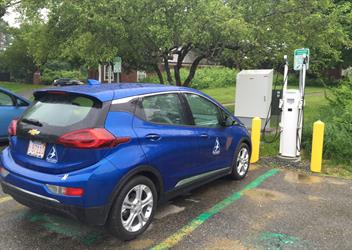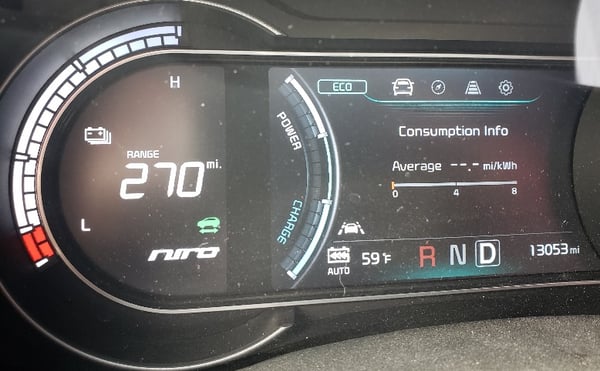
One of the most understated benefits of driving an electric vehicle (EV) is never stopping at a gas station again. In addition to saving money compared to gasoline, EV charging is the more convenient option for many drivers. Here’s why – and how you can get the best performance out of your battery.
What’s the difference between refueling with gasoline and charging with electricity?
Say you drive about 35 miles a day, about what most Americans drive on average. In this scenario, you could plug in once a week for a long time to completely recharge an electric car from 0% to 100%, This is how most people refuel on gasoline, which makes sense; a detour to the gas station is an additional errand as you drive between your home, the grocery store, work, and everywhere else. Since you’re going out of your way to refuel, the most time-efficient option is to go when your car’s fuel tank is empty.
EV charging is totally different because electricity is more accessible than gasoline. It takes just 5 seconds to plug in, and charging stations are located in places where you would park anyway, like at home, at the office, or at a public parking garage while going to restaurants, movie theaters, and other entertainment venues.
For this reason, EV drivers charge opportunistically, plugging into a station if it’s available nearby. For most people, this means charging when they arrive at home to replenish the miles driven that day, but an opportunistic EV driver will plug in anywhere to get a little extra juice.
|
“Last month, I drove to the Museum of Science. Getting there was within range, but I figured that I would be driving in hybrid mode on the way home. I was thrilled to find free charging in the museum parking garage so while I visited my car was charged for free and I was able to make the complete trip in electric mode.”
– Susan, Toyota Prius Prime
|
"But I don't have 60 hours to recharge!"
The chart below shows how long it takes to recharge a certain number of miles under the two most common charging speeds – Level 1, which charges a car at about 4 miles/hour, and Level 2, which charges a car at about 24 miles/hour. New to charging speed lingo? Read more here.
| Range |
Time to charge at Level 1 |
Time to charge at Level 2 |
| 35 miles |
8.5 hours |
1.5 hours |
| 100 miles |
25 hours |
4 hours |
| 240 miles |
60 hours |
10 hours |
Many potential EV drivers are intimidated by the fact that it can take 60 hours to recharge a pure battery-electric vehicle (BEV) using a regular household outlet. In practice, EV drivers find that plugging in saves time compared to driving to gas stations, and that most cars are parked long enough to have plenty of excess driving range. The average car is on the move only 6 hours per week and remains stationary for the remaining 162 hours in every week.
If you drive about 35 miles a day and leave your EV plugged into a regular outlet overnight, you can replenish the miles you drove that day without changing anything about your lifestyle. Surveys we’ve collected show than only about 55% of drivers have chosen to install Level 2 charging at home. 
Maybe you drive 240 miles a day regularly, in which case, waiting 60 hours for a full recharge is out of the question. Installing a Level 2 charger at home ensures that a night of charging restores the battery to nearly 100% again.
|
“We live in Mendon, MA, which is southeast of Worcester near the Rhode Island border. Range is an issue for us because we have to drive a long way to get anywhere. We've driven the Bolt up to Concord, NH, to Hartford, CT, to Sturbridge, MA, and routinely into Boston. Logan Airport is a 110-mile round trip for us, and is no problem. We installed a Level 2 (240-volt) charging station in our garage, which can charge the battery from empty overnight.”
– Rand and Carolyn, Chevy Bolt
|
Workplace charging can be just as convenient as charging at home, and many office spaces with an interest in sustainability are choosing to install charging as a perk to employees. Level 2 charging at many workplaces is free.

Mass Audubon has committed to installing EV charging stations at wildlife sanctuaries across the state.
Charging and battery health
Draining a lithium-ion battery down to 0% doesn’t only cause range anxiety; doing so consistently can be detrimental to the long-term health of the battery. Data from over 6,000 vehicles shows that EV batteries are robust enough to handle thousands of charge and discharge cycles over many years while maintaining good performance, which means that the large majority of EV drivers will never have to worry about replacing their battery.
Battery State-of-Health over Time

On average, EV batteries can be expected to lose about 2.3% of range every year due to natural aging. For a 250-mile range EV, that’s just 4 miles a year. Compare specific vehicle makes and models here.
Still, there’s no reason to take battery technology for granted. EV owners can be kind to their batteries by abandoning the old “gas station” paradigm for refueling cars and avoiding draining their battery to 0% as much as possible. Think of an EV battery like a cell phone; if you're around 20%, you should probably just plug in, regardless of when you'll need to drive next. At the same time, there's no need to charge to 100% consistently, unless you need to rely on the entire driving range of your vehicle. Staying between 20% and 80% battery capacity will leave you with plenty of driving miles and be gentle on the battery.
The one exception? In the wintertime, staying plugged in keeps the battery is warm. Since it takes battery power to heat up a battery to the optimal operating temperature, staying plugged in will extend the driving range some during cold weather. If you experience range loss of 30% or more, staying plugged in will ease range anxiety.

Battery health and Storage
Due to stay-at-home orders, cars are staying parked more than usual. Lithium-ion batteries don’t like to be stored at 100% or 0% for long periods of time because being at one extreme or the other puts excess strain on the battery.
 The Kia Niro EV has an EPA-estimated range of 239 miles, but can drive much further on a full charge during warmer weather. If you're not driving this far in a single day, there's no reason to keep your car at 100% charge all the time.
The Kia Niro EV has an EPA-estimated range of 239 miles, but can drive much further on a full charge during warmer weather. If you're not driving this far in a single day, there's no reason to keep your car at 100% charge all the time.
If you won’t be driving your car for a while, try to keep your car about half full. Some electric cars, such as the 2019 Chevy Bolt, let you determine your car’s maximum charge to make storage easy. Otherwise, charge until about 50% and then unplug if not driving for many days or weeks.
The major exception to this rule-of-thumb is Tesla, which recommends that drivers keep their cars plugged in during long-term storage. This is because the cars are connected to the internet for remote control and over-the-air software updates, which can drain the battery all the way down to 0% if the car is unplugged during storage. Always refer to an Owner's Manual to confirm the best storage procedure for your EV.
Takeaways
1. There's no need to drain an EV down to 0% before recharging, like you would when refueling with gasoline. Try to stay between 20% and 80% capacity, except when you need to rely on the full driving range of your vehicle.
2. When not driving your EV for a week or more at a time, leave the car's battery at about half-full.
3. During the wintertime, an EV can lose as much as 30% of driving range due to cold weather. Staying plugged in will keep the battery warm and maximize range.
 A generous donor will match up to $10k through September 30th. With your help, we could raise $20,000 for climate and clean energy!
A generous donor will match up to $10k through September 30th. With your help, we could raise $20,000 for climate and clean energy!





 The Kia Niro EV has an EPA-estimated range of 239 miles, but can drive much further on a full charge during warmer weather. If you're not driving this far in a single day, there's no reason to keep your car at 100% charge all the time.
The Kia Niro EV has an EPA-estimated range of 239 miles, but can drive much further on a full charge during warmer weather. If you're not driving this far in a single day, there's no reason to keep your car at 100% charge all the time. 
Comments